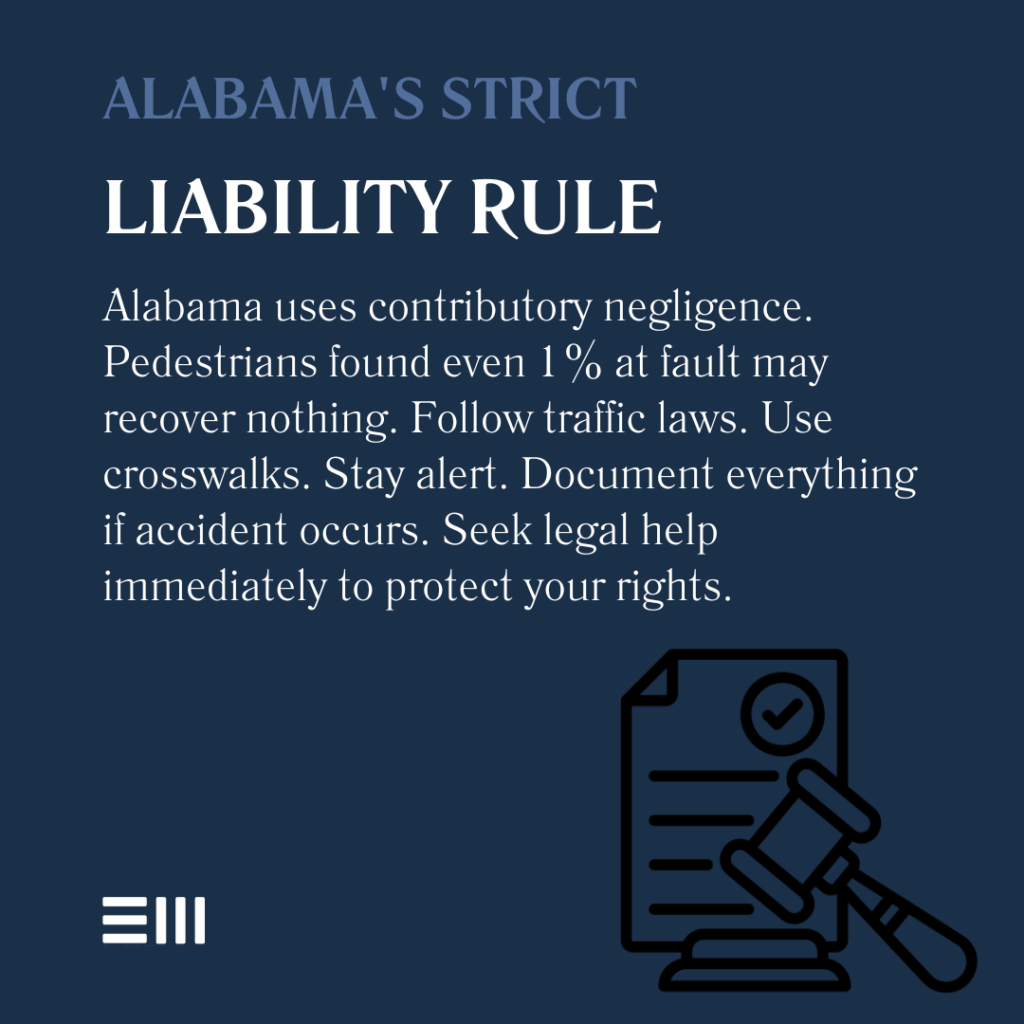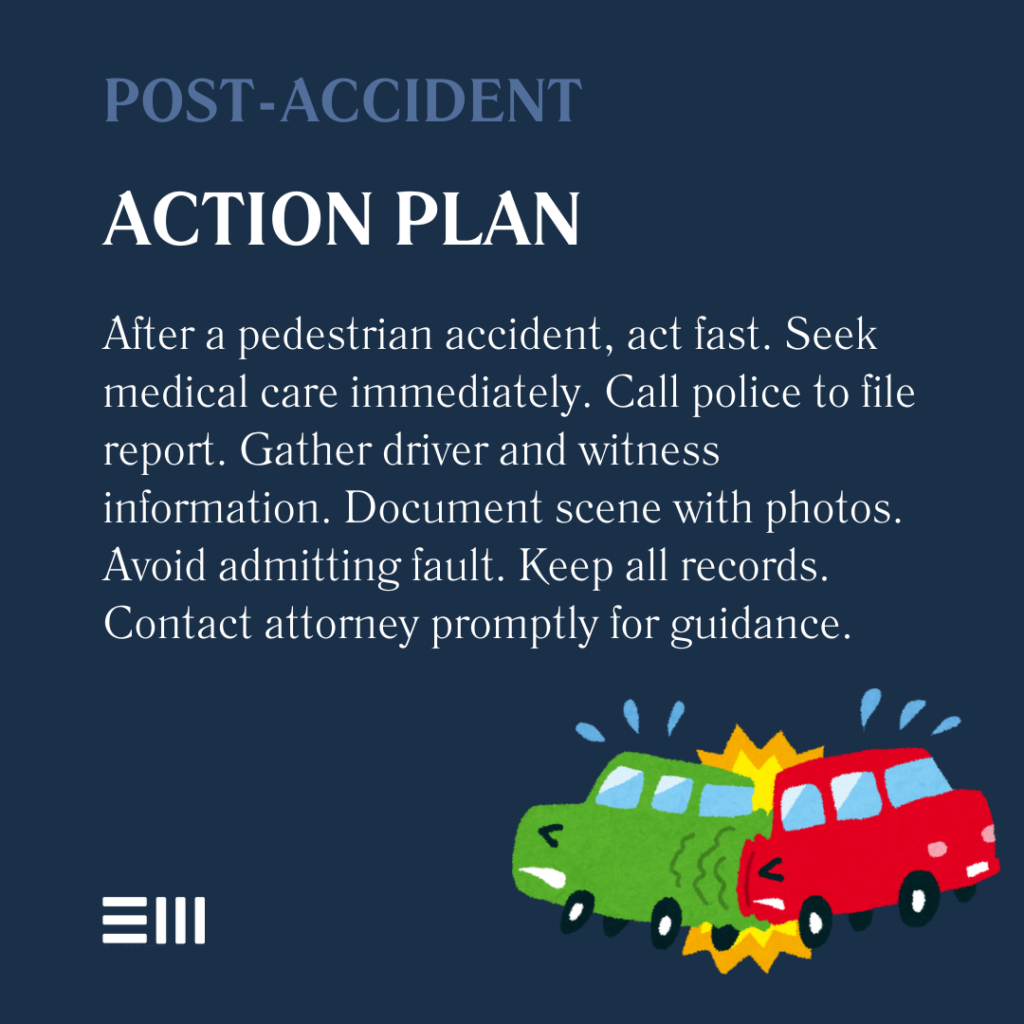
In the blink of an eye, a peaceful walk can turn into a life-altering event. Each year in Alabama, hundreds of pedestrians fall victim to traffic accidents, with many facing the additional challenge of navigating complex legal concepts like comparative negligence.
This comprehensive guide delves into the intricacies of pedestrian accidents, contributory negligence, and liability in Alabama, equipping you with the knowledge to protect your rights and seek fair compensation.
Common Causes of Pedestrian Accidents
Pedestrian accidents often result from a combination of driver and pedestrian behaviors, as well as environmental factors.
- Distracted driving;
- Speeding;
- Failure to yield right-of-way;
- Impaired driving;
- Poor visibility;
- Jaywalking; and
- Distracted walking.
Understanding these causes can help both drivers and pedestrians take preventive measures to reduce accident risks.
The Concept of Negligence in Pedestrian Accidents
Negligence forms the foundation of most personal injury claims, including those involving pedestrian accidents.
In legal terms, negligence occurs when someone fails to exercise reasonable care, resulting in harm to another person.
Elements of Negligence:
- Duty of Care: Both drivers and pedestrians have a duty to follow traffic laws and exercise reasonable caution.
- Breach of Duty: This occurs when either party fails to uphold their duty of care.
- Causation: The breach of duty must be the direct cause of the accident and resulting injuries.
- Damages: The injured party must have suffered actual damages, such as physical injuries or property damage.
In pedestrian accident cases, establishing these elements is crucial for determining liability and seeking compensation.
Alabama’s Contributory Negligence Rule
Unlike many states that follow a comparative negligence system, Alabama adheres to the stricter contributory negligence rule.
This rule states that if the injured party (in this case, the pedestrian) is found to be even 1% at fault for the accident, they may be barred from recovering any damages.
This rule can have severe consequences for pedestrians involved in accidents, even if the driver was primarily at fault.
For example, if a pedestrian is struck by a speeding driver but was jaywalking at the time, they might be deemed partially at fault and unable to recover damages.

Implications for Pedestrian Accident Cases
The contributory negligence rule makes it crucial for pedestrians to:
- Follow all traffic laws and safety guidelines;
- Be extra cautious when walking near roadways;
- Document the accident scene thoroughly if an incident occurs; and
- Seek legal counsel immediately after an accident.
Understanding this rule can help pedestrians better protect their rights and improve their chances of a successful claim if an accident occurs.
Determining Liability in Pedestrian Accidents
Establishing liability in pedestrian accidents involves a careful examination of the circumstances surrounding the incident.
Factors Considered in Liability Determination
- Traffic laws and regulations;
- Road conditions and signage;
- Visibility at the time of the accident;
- Actions of both the pedestrian and the driver;
- Witness statements;
- Police reports; and
- Surveillance footage, if available.
Common Scenarios and Liability Implications
- Crosswalk Accidents: Drivers are typically held liable for accidents occurring in marked crosswalks, as pedestrians have the right-of-way.
- Jaywalking Incidents: Pedestrians crossing outside designated crosswalks may be considered at fault, potentially barring them from recovery under Alabama’s contributory negligence rule.
- Distracted Walking: Pedestrians engaged in activities like texting while walking may be deemed partially at fault if an accident occurs.
- Impaired Driving: Drivers under the influence of alcohol or drugs are likely to be held liable, even if the pedestrian made some errors.
- Children as Pedestrians: Drivers are expected to exercise extra caution around children, who may not fully understand traffic rules.
Understanding these scenarios can help both pedestrians and drivers better assess their actions and potential liability in the event of an accident.
Legal Protections for Pedestrians in Alabama
Despite the challenges posed by the contributory negligence rule, Alabama law does provide several protections for pedestrians. Being aware of these can help individuals better assert their rights and navigate potential legal claims.
Key Legal Protections:
- Right-of-Way in Crosswalks: Drivers must yield to pedestrians in marked crosswalks and at intersections.
- Sidewalk Priority: Vehicles exiting driveways or alleys must yield to pedestrians on sidewalks.
- Duty of Care: Drivers have a legal obligation to exercise reasonable care to avoid harming pedestrians.
- Special Protections for Children: The law recognizes that children may not fully understand traffic rules and requires drivers to exercise extra caution around them.
- Pedestrian Safety Zones: Some areas may be designated as pedestrian safety zones, requiring drivers to exercise heightened caution.
These protections, while important, must be balanced against the strict contributory negligence rule when assessing potential claims.
Steps to Take After a Pedestrian Accident
The actions taken immediately following a pedestrian accident can significantly impact the outcome of any potential legal claim.
Here’s a step-by-step guide to protect your rights and strengthen your case:
- Seek Medical Attention: Your health is the top priority. Even if injuries seem minor, get checked by a medical professional.
- Report the Accident: Call the police to file an official report. This document can be crucial evidence in your case.
- Gather Information: Collect contact and insurance details from the driver. Also, get contact information from any witnesses.
- Document the Scene: Take photos of the accident scene, your injuries, and any property damage.
- Avoid Admitting Fault: Be careful not to make statements that could be construed as admitting fault, even partially.
- Keep Records: Maintain a file of all medical records, bills, and any other accident-related expenses.
- Contact an Attorney: Given Alabama’s strict contributory negligence rule, it’s crucial to seek legal advice promptly.
Following these steps can help preserve evidence and protect your rights in the complex legal landscape of pedestrian accidents in Alabama.

The Role of Insurance in Pedestrian Accidents
Insurance plays a critical role in pedestrian accident cases, often serving as the primary source of compensation for injured parties.
Understanding the types of insurance involved and how they apply can be crucial for navigating your claim.
Relevant Insurance Policies
- Driver’s Auto Liability Insurance: This is typically the primary source of compensation in pedestrian accidents.
- Pedestrian’s Health Insurance: May cover initial medical costs, subject to later reimbursement from a settlement.
- Pedestrian’s Auto Insurance: In some cases, the pedestrian’s own auto insurance (if they have it) may provide coverage, particularly through Personal Injury Protection (PIP) or Uninsured/Underinsured Motorist coverage.
- Homeowner’s or Renter’s Insurance: These policies may provide liability coverage if the accident occurred on or near the insured property.
Dealing with Insurance Companies
When dealing with insurance companies after a pedestrian accident:
- Be cautious about giving recorded statements;
- Don’t accept early settlement offers without legal advice;
- Keep detailed records of all communications; and
- Consider having an attorney handle insurance negotiations on your behalf.
Remember, insurance companies aim to minimize payouts. Having legal representation can help ensure you receive fair compensation for your injuries and losses.
Compensation in Pedestrian Accident Cases
If liability is established and the contributory negligence rule doesn’t bar recovery, pedestrian accident victims may be entitled to various forms of compensation.
Understanding these can help you assess the potential value of your claim.
Types of Damages
- Medical Expenses: Including current and future medical costs related to the accident.
- Lost Wages: Compensation for time missed from work due to injuries.
- Pain and Suffering: Non-economic damages for physical pain and emotional distress.
- Loss of Enjoyment of Life: Compensation for the impact of injuries on your ability to enjoy daily activities.
- Property Damage: Reimbursement for personal items damaged in the accident.
- Punitive Damages: In cases of extreme negligence or intentional harm, though these are rare.
The specific damages available depend on the circumstances of each case. An experienced attorney can help you understand and pursue the full range of compensation you may be entitled to.
Frequently Asked Questions About Pedestrian Accidents in Alabama
Understanding the complexities of pedestrian accidents and comparative negligence can be challenging.
Here are answers to some common questions to help clarify key points.
How Long Do I Have to File a Claim After a Pedestrian Accident in Alabama?
In Alabama, the statute of limitations for personal injury claims, including pedestrian accidents, is generally two years from the date of the accident.
It’s crucial to initiate legal action within this timeframe to preserve your right to seek compensation.
What if the Driver Who Hit Me Was Uninsured?
If the at-fault driver is uninsured, you may still have options for compensation:
- Your own uninsured motorist coverage (if you have it);
- Your health insurance for medical expenses; and
- A personal injury lawsuit against the driver.
Consulting with an attorney can help you explore all available avenues for recovery.
Can I Still Recover Damages if I Was Jaywalking When the Accident Occurred?
Under Alabama’s contributory negligence rule, jaywalking could potentially bar you from recovering damages, even if the driver was primarily at fault.
However, each case is unique, and other factors may influence liability. It’s essential to consult with an experienced attorney to evaluate your specific situation.
Protect Your Rights and Secure Your Future
At Baxley Maniscalco, we understand the intricacies of Alabama’s pedestrian accident laws and the challenges posed by the contributory negligence rule.
Don’t let confusion about comparative negligence or concerns about potential liability prevent you from seeking the justice you’re entitled to.
Contact Baxley Maniscalco today for a free, no-obligation consultation.
Can't find what you're looking for? Search our site below.










